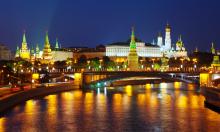Afghanistan, an American island in Central Asia
Utter lawlessness, loyalty to local militia warlords or drug barons and tribal issues are the key words in modern Afghanistan, a feud of the USA in Central Asia governed by a Prime Minister who owes his position – and his life – to the US special forces, not the people of Afghanistan.
The assassination attempt against Hamid Karzai on Thursday underlines the nature of modern Afghanistan – a country with an extreme proliferation of military equipment, intrinsically divided between local militia serving the personal interests of warlords, drug traffickers or the interests of neighbouring countries. It was this Afghanistan that the troops of the Soviet Union left after a decade of war against the US-backed Mujaheddin, which later developed into the Taleban movement led by Muhammad Omar.
In February, Hamid Karzai declared in an interview to the BBC that “the main problem is insecurity”, calling for more international forces to be stationed in Afghanistan. Since then, the money promised by international donors has been slow in arriving and progress in constructing a nation, destroyed by the USA and the Mujaheddin in the 1980s, has been close to nil.
The regime of Dr. Najibullah, which was the first to address the social and political issues of the Afghan people, giving women full rights and starting an educational programme which guaranteed schooling for all children of both sexes, launching a health programme which was second to none in the region, was overthrown by the CIA-led incursion by Mohammad Omar, Osama Bin Laden and the Mujaheddin movement in the 1980s. The mistake has not yet been rectified and among a number of reports by independent journalists and eye-witnesses, who have reported to Pravda.Ru, that the Taleban and Al-Qaeda are far from beaten and are active in many areas of Afghanistan, it does not seem close to being solved in the near future.
Last Thursday’s bomb attack and assassination attempt against Hamid Karzai and today’s bomb blast in Khost are symptoms of the disease which was disseminated by Washington in Central Asia. The result is the joke which is the “State” of Afghanistan, a state in which the government controls only the capital city, its suburbs and a few military bases, a state controlled by a government whose ethnic base is composed largely of the minority Northern Alliance, a state governed, de facto, by the multiple laws imposed by the warlords, not the ministers.
The process of disarmament of the civilian population has been painfully slow, due to the fact that this is a country where a young male is given a Kalashnikov and clips of ammunition for his sixteenth birthday present, while the country has dotted with weapons deposits, squirreled away during twenty years of conflicts.
The government of Afghanistan does not have the means to impose a rule of law in the country. As the international coalition loses interest, as inevitably it must, the tactic of patience adopted by the Taleban is bound to pay off, with Washington being drawn into a long drawn-out conflict similar to that which faced the Soviet Army, which soon discovered that in this terrain, control by a foreign power is untenable.
Washington may live to rue the day when Muhammad Omar was offered, and refused, money to build a pipeline through Afghanistan to transport Central Asian gas reserves and the decision was taken to attack Afghanistan...in 1998.
The question is what happens after Hamid Karzai, whose assassination appears to be a question of when, not if.
Timothy BANCROFT-HINCHEY PRAVDA.Ru
Subscribe to Pravda.Ru Telegram channel, Facebook, RSS!




